 This area makes up nearly half of the Catch & Release Area but it doesn't really have much holding water for any fish at all.
This area makes up nearly half of the Catch & Release Area but it doesn't really have much holding water for any fish at all. Little Missouri Fly Fishing
The Beginning! | July 11, 2010 | July 12, 2010 | July 13, 2010 | July 15, 2010
Sunday - September 4, 2005 The Permanent Catch & Release Area on the Little Missouri, at Riverside Park, contains a stretch we call the Skinny Water.
 This area makes up nearly half of the Catch & Release Area but it doesn't really have much holding water for any fish at all.
This area makes up nearly half of the Catch & Release Area but it doesn't really have much holding water for any fish at all.
The Skinny Water looking downstream >>>>
In addition there are large areas, several hundred square feet, of very shallow water over blank bedrock that almost sits still in the summer sun allowing the water temperatures to climb into dangerous levels for trout.
On one summer afternoon I took readings in the slow moving areas and got temperatures to 75° while just 20 feet away, where the water was moving, the temperature was 67°! (This was before the #3 generator was back on line by the way.) That's a dramatic difference! And every bit of that warmer water has to blend with the cooler water which raises the overall temperatures as well as decreasing the dissolved oxygen content.
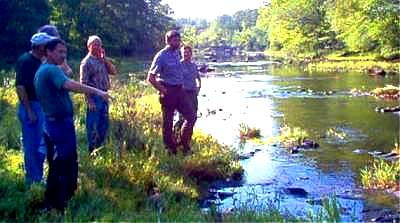 For some time I've been speculating about the possibility of modifying parts of this stretch to move the water through the zone faster and at the same time create some deeper potential pocket water habitat which could hold fish on a regular basis. Currently between the Closed Zone line and The Chute there are really only two places that would hold trout on low water.
For some time I've been speculating about the possibility of modifying parts of this stretch to move the water through the zone faster and at the same time create some deeper potential pocket water habitat which could hold fish on a regular basis. Currently between the Closed Zone line and The Chute there are really only two places that would hold trout on low water.
One of the things that concerned me was how to keep the stretch as natural looking as possible and still get the desired effect. Rather than building weirs such that exist elsewhere on the Little Missouri I thought more along the lines of low level rip-rap "islands" that would sharpen the flows and cover the shallow areas. My hopes are that grasses will eventually be able to take hold on these islands and before long you'd have a hard time seeing that something was done at all!
The next step was to see if the project could happen at all!
Early in August 2005 I managed to get a date set to meet with Steve Filipek, AGFC Stream Team Director and Ned Hollenbach, Lake Greeson Project Manager for the Corps for Friday, September 2. That morning Steve, Ned and I were joined by Drew Wilson and Les Claybrook of the AGFC and Gary Lamers, Ned's right hand man with the Corps as well as our own Johnny McJunkins!
We wanted to take a look at what could be done, if there were any possible adverse effects to consider, if there was any potential opposition to consider and even if it is a worthwhile effort! Everyone seemed to think all aspects were positive and that we could move to the next steps, which will be approval, logistics and funding.
Steve suggested a series of rip-rap triangles, "chevrons" and wedges located to "pinch" the flows with a funneling effect. There are natural bedrock ridges to take advantage of and follow in those spots so we'd be kind of enhancing the existing "lay of the land". With a little computer work I can give you an idea of how things possibly might look - before and afters so to speak:
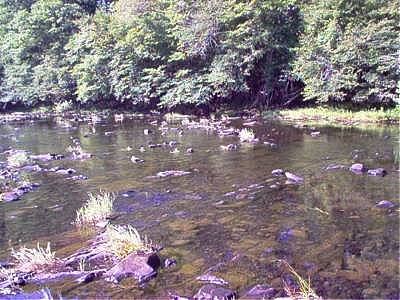
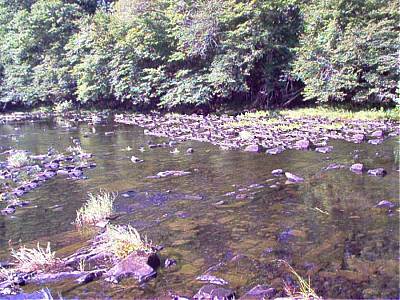
The most upstream possibility - before on the left - after on the right. You can see, we're not talking about a huge amount of change, but strategic location more than anything else!
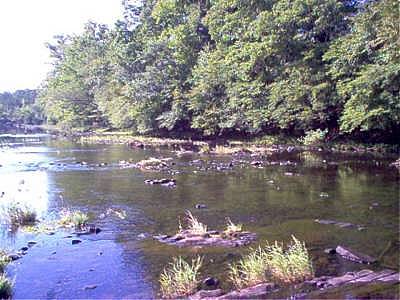
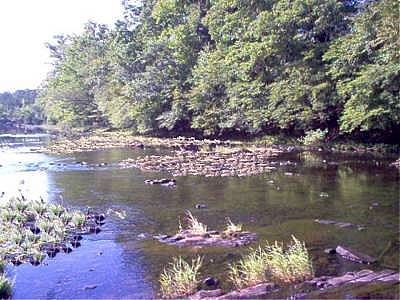
Steve even took the time with Johnny and I to take the measurements of the potential areas to do his calculations as to what it was going to take to do the work.
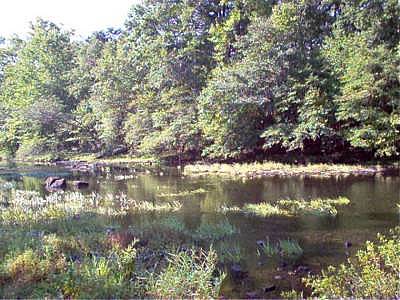
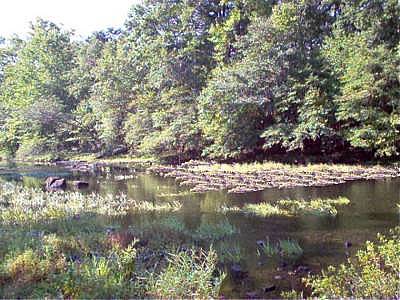
One of the things to take care of is the applications by the AGFC and Corps for the "404 Clean Water Act". Steve will prepare a report/proposal and get it to the Corps and AGFC and we'll see where to go after that!
Sunday - July 11, 2010
So, in the five years since that September morning it seems that not much has happened! In fact a whole lot has happened!
At the time, Head Trout Biologist Darrell Bowman was beginning the process of re-thinking how the AGFC Trout Program operated! He certainly had the Skinny Water Project on his list though. But his primary concern was developing a new "game plan" for the over-all Trout Management Plan in all of Arkansas. That's a tall order after all!
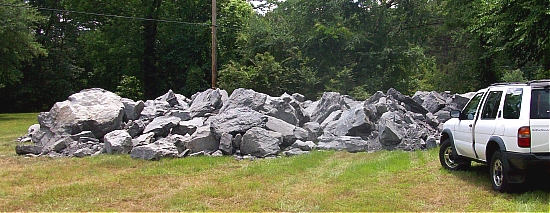 In 2007 Jeff Williams took over the Trout Program duties and vowed to continue the path that Darrell had started down! The Skinny Water was kind of set on the back burner while the Trout Management Plan was developed, solidified and put into operation.
In 2007 Jeff Williams took over the Trout Program duties and vowed to continue the path that Darrell had started down! The Skinny Water was kind of set on the back burner while the Trout Management Plan was developed, solidified and put into operation.
First load of BIG boulders shows up in late May 2010! >>>>>
When all was said and done after the implementation of the Management Plan, Jeff assured me that the Skinny Water Project was part of the Little Mo' plans.
Of course it takes a while to get things from paper to action - as with most government entities of any sort - about two years.
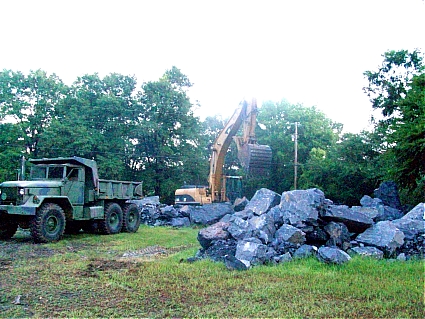 So back in May (2010) all of a sudden I get an e-mail from the Little Mo's own new Trout Biologist, Christy Kitterman (an aspect of the new Management Plan), saying that rock was going to start being hauled to the river for the Skinny Water Project to get underway!!!
So back in May (2010) all of a sudden I get an e-mail from the Little Mo's own new Trout Biologist, Christy Kitterman (an aspect of the new Management Plan), saying that rock was going to start being hauled to the river for the Skinny Water Project to get underway!!!
Already working on a rainy Sunday evening! >>>>>
Well I certainly wasn't ready for that! In fact, the CORPS was even planning no generation the following week just for the Project! Unfortunately the contractors weren't going to be available that week and then we had the awful Albert Pike flood that raised the lake five feet in less than 24 hours. So we were into a high water situation anyway and the CORPS had to run water for another week!
Going into the heat of summer I was more concerned that shutting down generation just for the Project would be a bad thing and suggested that they wait until fall when we could expect low water without temperature issues. I figured we were in a "waiting for October" mode...
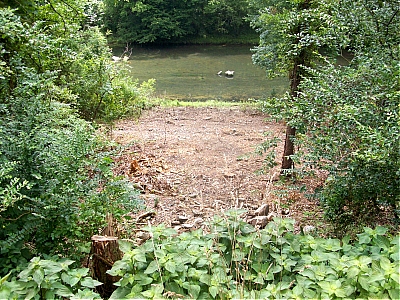 Well on July Wednesday July 7, I got another e-mail from Christy that they were going to go ahead and start Monday July 12th! What a shock after all! The Habitat gang felt that they could get plenty of work done before the 2 PM daily generation time and started bringing in the heavy machinery!
Well on July Wednesday July 7, I got another e-mail from Christy that they were going to go ahead and start Monday July 12th! What a shock after all! The Habitat gang felt that they could get plenty of work done before the 2 PM daily generation time and started bringing in the heavy machinery!
<<<<< The "LZ" Landing Zone looking down from the upper terrace along Hwy 19.
This afternoon (Sunday the 11th) two of the contract crew showed up at Riverside in a heavy downpour, but I headed back into town for supper! Later I got the call from John Balch (lives across from Riverside) that there were things happening up at the Park! I scooted on back!
There I met with Eli Powers, AGFC Trout Habitat Program #2 man, and we talked about what was going to take place on Monday. In the meantime, the crew had already rolled nearly half of the rock and huge boulders down to a Landing Zone that the CORPS had already cleared on the river level terrace just below the Skinny Water.
All of a sudden the Skinny Water Project is going to happen this week! More tomorrow!
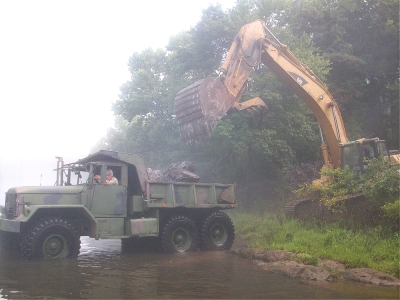 Monday - July 12, 2010
Monday - July 12, 2010
Work began early this morning in earnest! Around 7 AM the crew was loading rocks into the truck and rolling the 10,000 pound boulders up to the Skinny Water and dumping them on location to be moved later.
The monster track-hoe loads the first batch of boulders off of the "LZ" in the morning fog! >>>>>
In the meantime they got the back-hoe hydraulic hammer to work on the bedrock! That's a seriously tedious job and the guys remarked on several occasions that this stone was really hard and dense!
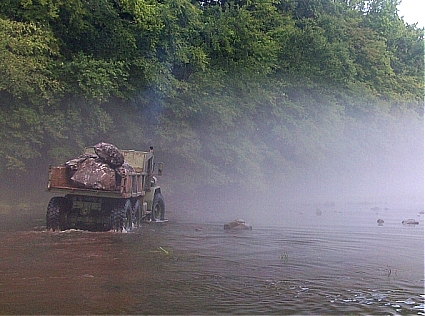 Inch by inch, he broke up the bedrock into chunks anywhere from a softball to a couple of feet long. The hammer was non-stop, except to re-grease the mechanism periodically, so there was a lot of yelling going on!
Inch by inch, he broke up the bedrock into chunks anywhere from a softball to a couple of feet long. The hammer was non-stop, except to re-grease the mechanism periodically, so there was a lot of yelling going on!
<<<<< And the first truck-full of rock heads for the Skinny Water.
When the track-hoe did dig up some of what had been broken it revealed just how much had already been chipped out. Eli suddenly was standing in a knee deep hole where earlier it was maybe three inches of water!
The plan is to dig out as much of a channel as possible between the constrictors and the island that is going to be in the center of the stream bed.
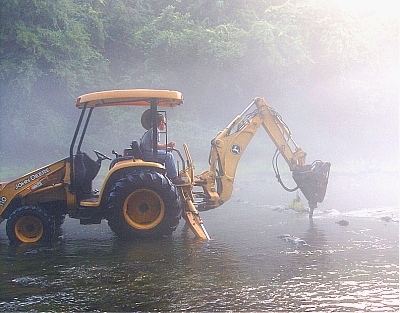 All the while the dump truck is making run after run with a full load of boulders. Eventually they had enough in the stream bed to start putting them into place. That's when they brought the track-hoe down and got after it!
All the while the dump truck is making run after run with a full load of boulders. Eventually they had enough in the stream bed to start putting them into place. That's when they brought the track-hoe down and got after it!
<<<<< Hydraulic hammer going to work on the bedrock.
He was picking up VW Bug sized boulders and setting them in a line to essentially build a retaining wall that would form the outside lines of the "constrictors". They started setting the upstream east-bank structure first.
 Once the retaining walls are in place they will start to fill in the structure with smaller stuff to make them a solid extension of the river bank.
Once the retaining walls are in place they will start to fill in the structure with smaller stuff to make them a solid extension of the river bank.
The track-hoe and dump truck cross paths - while on the bank, Eli Powers, gives you a sense of scale! >>>>>
These opposing triangular shaped, but somewhat staggered, constrictors will jut out into the stream bed from both banks forcing the water to flow deeper and faster in between. And it's in between that the channels will be dug out.
Today they got as far as setting the outline of the upstream east and about half of the upstream west constrictor. And breaking up about 30 feet of bedrock in the east bank channel.
I told Eli at one point as things began to take shape that I imagined he was used to seeing this kind of thing, but for me it's pretty surreal! 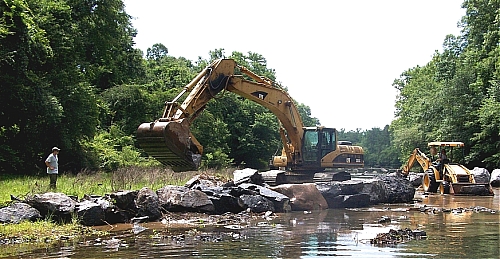 I also questioned if this wasn't one of the more dramatic projects they've done as far as changing stream bed habitat.
I also questioned if this wasn't one of the more dramatic projects they've done as far as changing stream bed habitat.
<<<<< Setting some of the "medium" boulders to create the retaining wall of the upstream east side constrictor.
He said it was fairly significant, but that the recent Dry Run Creek work was probably more substantial still! I haven't been up there yet to see what they've done - maybe this year's Conclave!
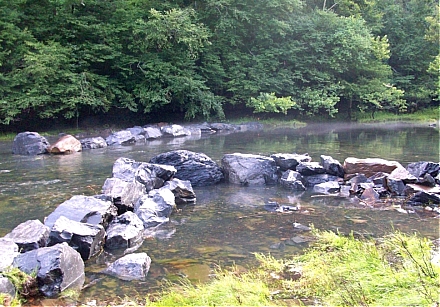 As the retaining boulders sat in place for a while I began to see overhanging grasses and trees on top of them shading the channels! The constrictors are substantially larger, or higher actually, than what I had originally envisioned and the probability of real trees taking root in these is much more feasible!
As the retaining boulders sat in place for a while I began to see overhanging grasses and trees on top of them shading the channels! The constrictors are substantially larger, or higher actually, than what I had originally envisioned and the probability of real trees taking root in these is much more feasible!
The upper east-bank retaining wall in place. This will be filled in with more stones, scooped out cobble from the broken bedrock - and eventually autumn leaves and new growth! >>>>>
I spoke to Eli about the likelihood of The Friends of the Little Mo' planting trees and he said that one of the best ways to re-foliate is to cut willow branches this summer and simply poke them into the fill! They will take just from cuttings like that!
So later after all is said and done, every time ya'll go in there, take a plant or two of some sort and just stick them into the tops of constrictors!
But I'm getting ahead of ourselves! However, after the crew had quit for the day and got the machinery back out of the river Mike Ingram and I went back up just to look around and I saw one trout already hanging around where the jack-hammer had been just 30 minutes before!
I'm taking that as a good omen!
Tuesday - July 13, 2010
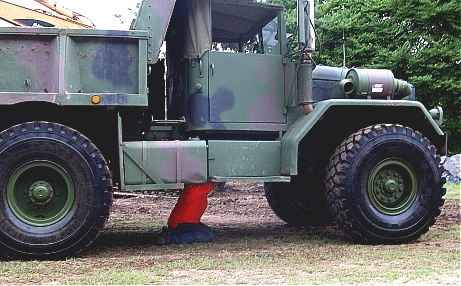 Well, it's never a good sign when you pull up and there's a guy up under a truck with a wrench!
Well, it's never a good sign when you pull up and there's a guy up under a truck with a wrench!
Fortunately it was just an air line hose coupling and a quick run to the NAPA store in town took care of that! But it's not much fun when you've got no brakes on a vehicle like that with a several thousand pounds of boulders in the back!
<<<<< Not only does Chad Sentell know what to do with a track-hoe - he's apparently got a clue what's going on under there.
Crisis averted and back to work they went.
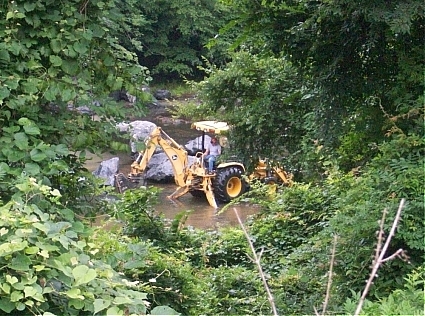 I feel obliged to mention the guys who are doing all of this, as they are doing some semi-miraculous work as far as I'm concerned.
I feel obliged to mention the guys who are doing all of this, as they are doing some semi-miraculous work as far as I'm concerned.
J.W. Brooks all by himself, still breaking up bedrock while the truck was being repaired! >>>>>
Of course I've already mentioned Eli Powers with the AGFC and then there's Tony Crouch (AGFC) doing most all of the truck driving and carrying of the rock!
The contract guys, who work frequently with the AGFC Habitat Program, are J.W. Brooks currently running the hammer on the back-hoe and Chad Sentell doing some really delicate work with that huge track-hoe! My great thanks to these guys for doing some tedious, but tremendous work!
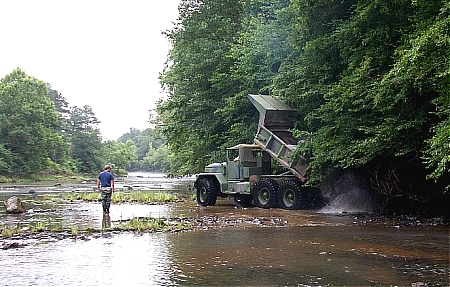 Once the truck was up and running again it was back to hauling boulders and fill for the constrictors. The upstream west-bank structure was nearly filled in by the time I got down there already and there were more boulders ready to be placed for the island.
Once the truck was up and running again it was back to hauling boulders and fill for the constrictors. The upstream west-bank structure was nearly filled in by the time I got down there already and there were more boulders ready to be placed for the island.
<<<<< Tony Crouch delivers the first rocks for the downstream west-bank constrictor...
And, as yesterday, and I'm sure tomorrow and the next day, J.W. was constantly breaking up bed-rock, stopping only to reposition or grease the spike! It wasn't until later when Chad got in there with the track-hoe did we really see just how much breaking was going on!
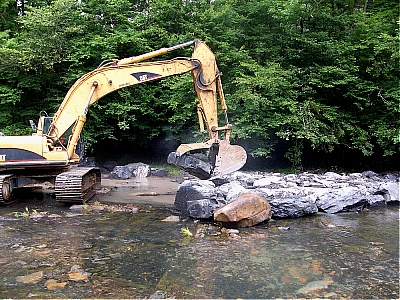 The work today was much more dramatic than yesterday, almost like yesterday's doings were still just preparations. They completed the two upstream constrictors and filled them in for the most part! They started placing the forward wall of the downstream west-bank constrictor and the first boulders for the island.
The work today was much more dramatic than yesterday, almost like yesterday's doings were still just preparations. They completed the two upstream constrictors and filled them in for the most part! They started placing the forward wall of the downstream west-bank constrictor and the first boulders for the island.
<<<<< Chad "sets" a boulder in place!
Chad, as I mentioned, did amazingly delicate work with the shovel of the track-hoe. He was moving boulders around like they were checkers on a board! He even gingerly flipped the lead boulder of the island the same way you'd turn over a standard brick with your finger tips! I called that one the "Moses Stone" since Eli mentioned that "That one is really going to separate some water!"
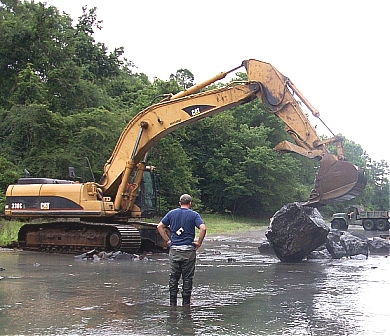 On the other hand he also played Mega Whack-a-Mole with the boulders of the constrictor fill - slamming the shovel down on the stones and leveling them like apple slices in a pie tin! It was quite fascinating!
On the other hand he also played Mega Whack-a-Mole with the boulders of the constrictor fill - slamming the shovel down on the stones and leveling them like apple slices in a pie tin! It was quite fascinating!
Chad tips over the "Moses Stone" while Eli gets it where he wants it! >>>>>
The scale on which these guys are working is far beyond what I had originally conceived! You're going to find that the structures are rather straight edged, but what they are going to do in the long run as far as trout habitat - particularly on high water - is going to be rather significant!
The locations and shapes of the constrictors are going to create holding water during generation - something that simply did not exist at all in the Skinny Water. You know, we may have to start calling it something else, eventually!
At any rate, there are going to be deep eddies and vertical eddies behind these things as they jut out at big angles, not unlike the big bedrock ledges of the Wall Hole and the Meat Hole.
 These eddies will provide great relief from the high water and I anticpate fish holding there rather than just running through it! Once high water has fallen out, the new holes that are being created will give them a lot more cover.
These eddies will provide great relief from the high water and I anticpate fish holding there rather than just running through it! Once high water has fallen out, the new holes that are being created will give them a lot more cover.
<<<<< With the leading walls of the island in place the guys start on the front wall of the downstream west-bank constrictor!
"Hide out" structures, otherwise known as Lunker Bunkers, are also being contemplated as work progresses. Eli has already seen locations that would be suitable for additional structures!
So, even though the structures may not be as aestheically pleasing (yet!) as I had originally pictured back in 2005, the grand scheme is going to be considrably more productive than I had previously imagined!
As I mentioned earlier, once Chad got back in there today with the track-hoe, in J.W.'s busted up channel he dug out the loose stone and started using it for fill behind the constrictor walls. He did some serious digging out. You could feel the shaking underfoot as he broke huge chunks of bedrock on his own account as well, picking up 300 and 400 pound boulders and tosing them into place!
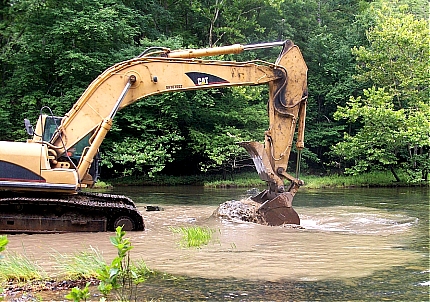 Of course, that left deep pockets in the main channel, upwards of three feet deep already, where the water had previously been ankle deep a couple of days ago! And he's just getting started with that process!
Of course, that left deep pockets in the main channel, upwards of three feet deep already, where the water had previously been ankle deep a couple of days ago! And he's just getting started with that process!
A big scoop of gravel comes out of Dammit Flat, leaving quite the impression - or rather - depression!! >>>>>
Chad also gathered some of the gravel from Dammit Flat to use for fill and he was able to get a couple of scoops out of there that went deep into the loose bottom. No bedrock there! We may be looking at a much larger three foot deep hole in that area later on!
They finished out the afternoon with the placement of the wall for the downstream west-bank constrictor and more of the island before it was time to get out.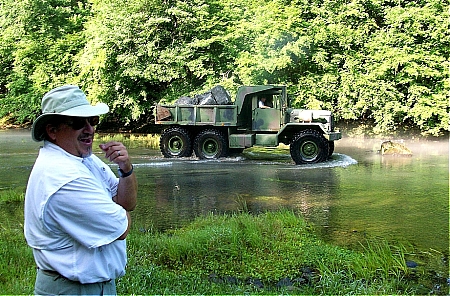
Eli mentioned that this is a somewhat unique situation where they are getting to see what effects high water has immediately, each day. Most projects, they don't know how hydraulics are acting and what's holding up or washing away until much later when there's a flood or high water period.
We also talked about the fact that it's pretty cool to build a trout stream from scratch - where there was virutally nothing, but some water!
Yep... It's pretty cool!
Thursday - July 15, 2010
Done, and done!
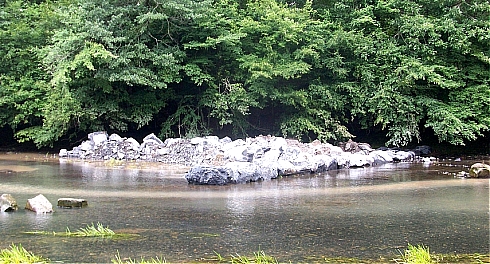 The work on Wednesday went very fast and effeciently leaving only the construction of the smallest of the constrictors on the east bank, filling in the structures and some channeling throughout! It was looking like Eli's anticipation of being done today was within reach.
The work on Wednesday went very fast and effeciently leaving only the construction of the smallest of the constrictors on the east bank, filling in the structures and some channeling throughout! It was looking like Eli's anticipation of being done today was within reach.
The downstream west bank constrictor takes shape. >>>>>
And, in fact, they were done in no time this morning!
The downstream constrictor, by far the largest of the structures, was finished quickly and Chad moved on to dredging and using what he dug out to fill in the rip-rap. He put knee and thigh deep holes in places that were once just a few inches deep and the water over it was barely moving.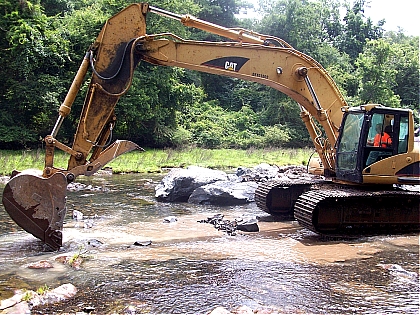
The previously largest area of shallow still-water was now under the downstream constrictor and a channel was being dug out in front of that retaining wall. This should eventually scour under the force of high water and form a bit of a cut-bank!
<<<<< Chad dredges the channel on the west side of the island...
There is also now a small additional structure on the west side between the island and the downstream constrictor. This one should give fish a little more respite on high water. Just one more little cranny to sneak into - especially on the "cold water" side!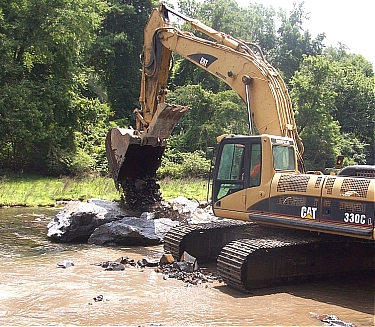
By this time it was all pretty much up to Chad and the track-hoe! J.W. was finally, and I'm certain, thankfully done breaking up bedrock and he was up at the launch site cleaning up and leveling the grassy area back out. It won't be long before you'll never know all that was up there going on.
And drops the fill onto the island! >>>>>
We DO need to see what we can do about re-foliating the hill-side and getting grass started up there again though! I'm going to be checking in with Ned Hollenbach soon to see how we can help with that - not to mention maybe a foot trail continuing up the bank to the site! More on that as it develops!
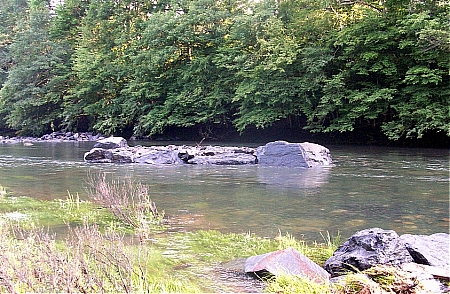 Back in the stream bed, Chad was channeling out a few run lines and placing a few critical boulders to force water where Eli wanted it to go. Before I knew it, it was "thumbs up" and the guys were heading out for the last time!
Back in the stream bed, Chad was channeling out a few run lines and placing a few critical boulders to force water where Eli wanted it to go. Before I knew it, it was "thumbs up" and the guys were heading out for the last time!
<<<<< Falling water Wednesday evening! Very nice...
It was strange feeling to have seen this happen bit by bit. You guys will come and see something that wasn't there the last time you were in there! And many of you probably have never tried to fish the Skinny Water as it was! I hope we'll have much more reason for more of you to go up in there.
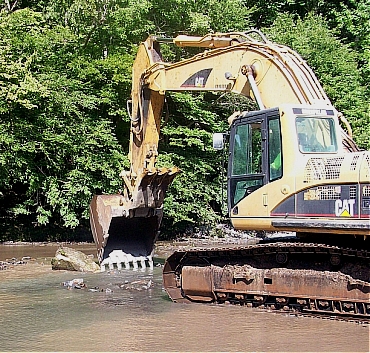 The last thing Chad did on the way out was to bring down from the LZ a very large boulder that I beleive was actually un-earthed from the hill side. It was too big to bring up to the site, so the crew left one more mark by placing it in the river, right above "Bill's Rock"! There's a new Bill's Rock just off the bank now. When you first see it I suspect the reaction will be something along the lines of "Holy Cow"!
The last thing Chad did on the way out was to bring down from the LZ a very large boulder that I beleive was actually un-earthed from the hill side. It was too big to bring up to the site, so the crew left one more mark by placing it in the river, right above "Bill's Rock"! There's a new Bill's Rock just off the bank now. When you first see it I suspect the reaction will be something along the lines of "Holy Cow"!
"Strategic" boulder placement! >>>>>
I walked around the entire site several times after everyone had gone and watched the "smoke clear". As the water flowed through three times faster than ever before, it cleared out nicely and the Skinny Water started to take on the feel of the Upper River with its big boulders, riffles and pockets.
Below: "Off they go" - All done!
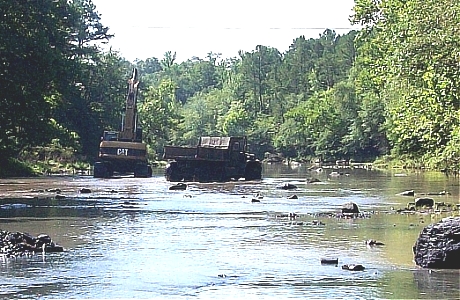 The enormity of the structures should give fish several places to hang on high water. There's no less than eight back-eddies available to them now! And those are 2 1/2 to 3 1/2 feet - even four feet - high! That's a lot of room for vertical eddies that trout ride behind these big rocks on high water. And once the water falls, there's going to be nice little runs and feeding lanes, particularly coming off of Dammit Flat.
The enormity of the structures should give fish several places to hang on high water. There's no less than eight back-eddies available to them now! And those are 2 1/2 to 3 1/2 feet - even four feet - high! That's a lot of room for vertical eddies that trout ride behind these big rocks on high water. And once the water falls, there's going to be nice little runs and feeding lanes, particularly coming off of Dammit Flat.
All of this, however, is NOT going to be easy fishing. It's going to take significant stealth, clean casting and accuracy! Don't go tromping around in there willy-nilly and expect to find fish. It's going to be easy to spook the resident fish out of there. For those who like a challenge, this will be the place to look into!
Here's some "for real" before and afters!
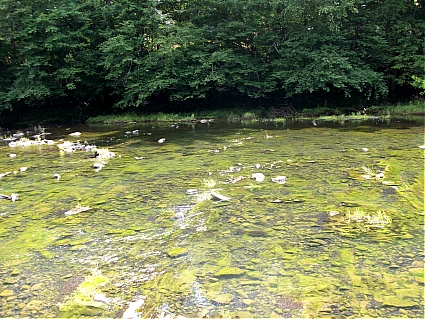
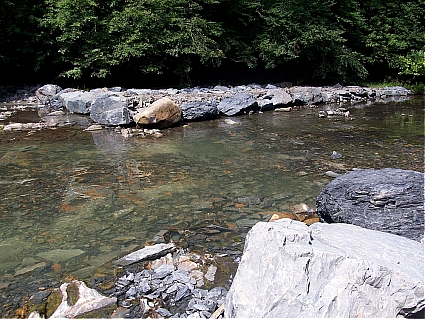
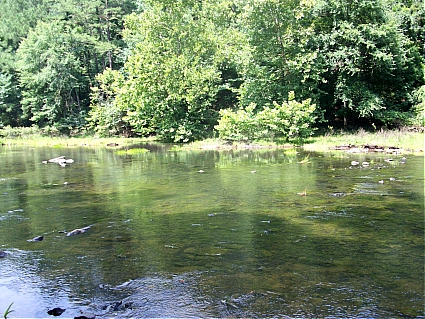
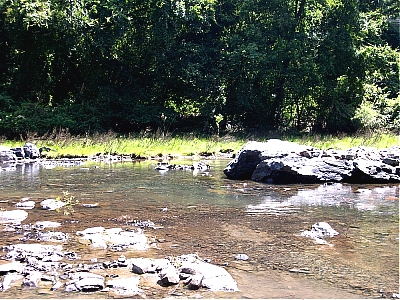
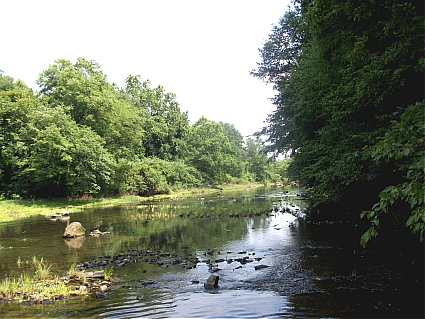
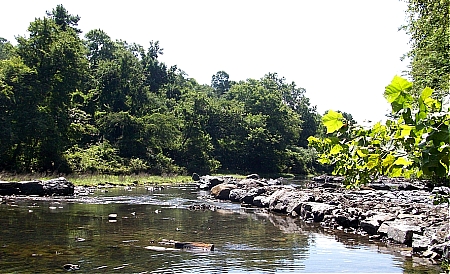
Once we get a fresh crop of fish in there this fall, I think those may be more likely to adapt to the stretch. The current residents are likely to be pretty wary of an area that they were accustomed to being a dangerous place! On the other hand, they may find it a nice place to be quickly after a few weeks of regular cycles of generation and low water.
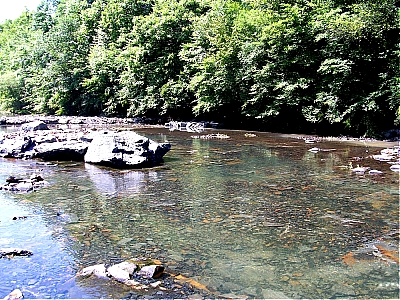
I can't begin to thank the AGFC Trout Habitat Program for the work they've done so suddenly and so quickly! And certainly enjoyed visiting, discussing stream features and predicting hydraulics, and telling stories with Eli as he rock-hopped around directing traffic. I hope I wasn't in the way too much!
Habitat Director Tim Burnley made it down today to get an overview as well! I think he was pleased. He did tell me today that the estimated cost for the entire thing was going to be around $24,500 with the 800 tons of rock being about just $2,000! Eli had related that the rock was a real bargain coming from the Certain Teed quarry near Glenwood. It was, as he put it, scrap! Hard to imagine a 10,000 pound piece of scrap!
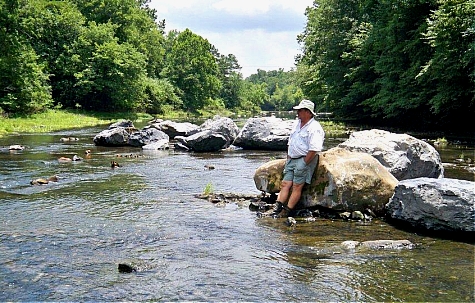 At any rate, Tim mentioned that the rock could have cost as much as $13,000 coming from elswhere and total cost of delivering the 800 tons could have added as much as $27,000! We, or I should say the AGFC, got a real deal on this project. I asked how this was funded - you guys paid for it! The Trout Habitat budget is generated by NON-resident Trout Permits only! The Habitat Program gets $2.50 of every $12 Trout Permit!
At any rate, Tim mentioned that the rock could have cost as much as $13,000 coming from elswhere and total cost of delivering the 800 tons could have added as much as $27,000! We, or I should say the AGFC, got a real deal on this project. I asked how this was funded - you guys paid for it! The Trout Habitat budget is generated by NON-resident Trout Permits only! The Habitat Program gets $2.50 of every $12 Trout Permit!
Just pondering... >>>>>
Eli was contemplating things that can be done in the project area later on down the road, such as Lunker Bunkers and some additional strategic boulders as "baffles" to direct and manage flows through the runs. We'll see what the river does on its own for a while and he'll revisit things later on!
So! The Skinny Water "construction" process is done! The Skinny Water development has just begun!
I can't wait to put up the first picture of a fish holding in the pocket water or a fish caught from the NEW Skinny Water!